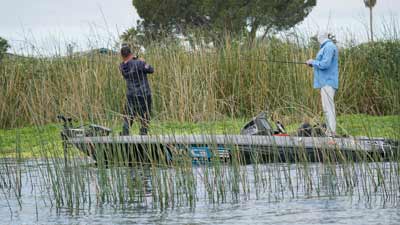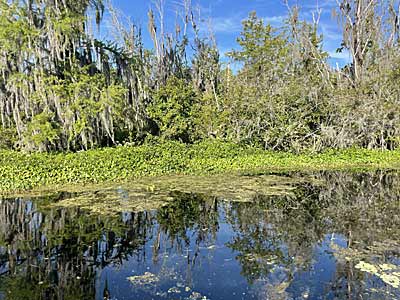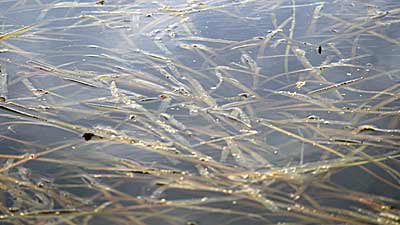
Fishing aquatic vegetation is one of the easiest ways to ensure that you are around fish. Bass love the stuff and will often be near grass, swimming through it looking for food, using the grass lines as they travel, or hiding beneath it for shade. Bass of all species use it at times, but largemouth are especially fond of vegetation.
Each type of vegetation provides opportunities to catch fish, and knowing about each and how to fish it effectively will make you a better bass angler.
Emergent vs. Submergent Grasses
The first thing to learn about vegetation is whether it is emergent or submergent, with emergent grasses rooting into the bottom and growing up from the bottom and above the surface. Emergent grasses are shallow-water targets such as reeds, cattails, tules, and water willow.
Submergent vegetation is underwater entirely and includes milfoil, pondweed, hydrilla, and eelgrass: all great places to catch a bass. They will sometimes reach the surface and create a mat, which offers shade and protection for bass and small baitfish.
No matter how grass grows or species, some bass will be around it. Here is a quick rundown of some popular vegetation species and tips for targeting them.
Reeds, Cattails, Tules, Bulrushes, and More
The above names are often interchangeable and called different names based on region, but fishing them is universal, even if they are different grass species. Since they stand up straight out of the water in shallow water, fishing them is highly visual.

One of the best ways to fish this vegetation type is by pitching and flipping jigs or soft plastics into the gaps. Between each reed or tule is an excellent spot to place your bait, as bass can easily hide between the many stalks of this type of vegetation. Also, pay close attention to any movement you see with them, as a bass swimming through them will give you a clue to their location with subtle shakes in the tall grass as they move.
Since this type of vegetation often stretches long distances and looks the same most of the time, it can be difficult to pinpoint where to start.
The best advice is to focus on areas that are slightly different than everything else. It could be where the reeds form a point, sections with somewhat deeper water, or areas where other grasses are mixed in. These subtle differences give fish something to hold to and offer you a high-percentage place to fish.
Another way to fish emergent grasses is to work the edges with fast-moving baits. Lures like ChatterBaits, swimbaits, and spinnerbaits are good choices as they are relatively weedless and can be fished quickly in search of active fish.
Hydrilla, Pond Weed, and Milfoil
Each of these three types of vegetation is great for bass, and fishing them effectively depends on how high they grow in the water.

Later in the year, your options are limited as they reach the surface and form a mat. You'll be able to fish above them with a frog or weedless worm, but that is about it. Your other choice is to get a big weight for your Texas-rigged plastic and punch through the mat for fish.
Like all other vegetation types, it pays to find a mixture of different grasses coexisting. The slight changes between species offer something different, and bass will gravitate to these areas.
Before the grass reaches the surface, there are many more options. Soft plastics and jigs are great options for pitching to the edges, as are vibrating jigs, spinnerbaits, and crankbaits along the edges.
Anglers can fish the small holes between grass, the edges of the grass, or places that are barren of grass completely. These minor differences pay big dividends in a massive stretch of aquatic vegetation. The slight differences and changes appeal to bass, using them to look for their next meal. A swim jig is one of the best tools for scattered grass and slight irregularities in vegetation, as they are weedless and can be worked through all grasses.
Eelgrass

While eelgrass is similar to other emergent grasses, it is a little trickier to fish because of the thick blades of grass. It looks almost like the grass on your lawn on a larger scale.
Since it is thicker, it tends to hang up easier with an open hook, and some of the best ways to target it are with a frog above it or a swimming worm or weedless swimbait worked between each blade of grass.
ChatterBaits and crankbaits are excellent options for locating the deeper defined edges and where they become more scattered.
Lily Pads
Lily pads are located in many different regions and are a prime location for bass fishing. They provide ample shade for bass and will live near them year long, even using the mass of stems and stalks as sites for spawning beds.
While they offer much shade, there are not too many ways to effectively fish them as the creases between pads and the stems themselves are great at snagging a fishing line.
Flipping and pitching baits into the holes between pads is one of the best ways to fish them, and fishing a frog over top of them will also produce fish. Don't overlook the outside edges of pads, as they can be great for spinnerbaits, swimbaits, and ChatterBaits.
The many different species of aquatic vegetation are prime locations to find bass. Knowing about the different species, what to look for, and how to fish them correctly will help you land more bass.




